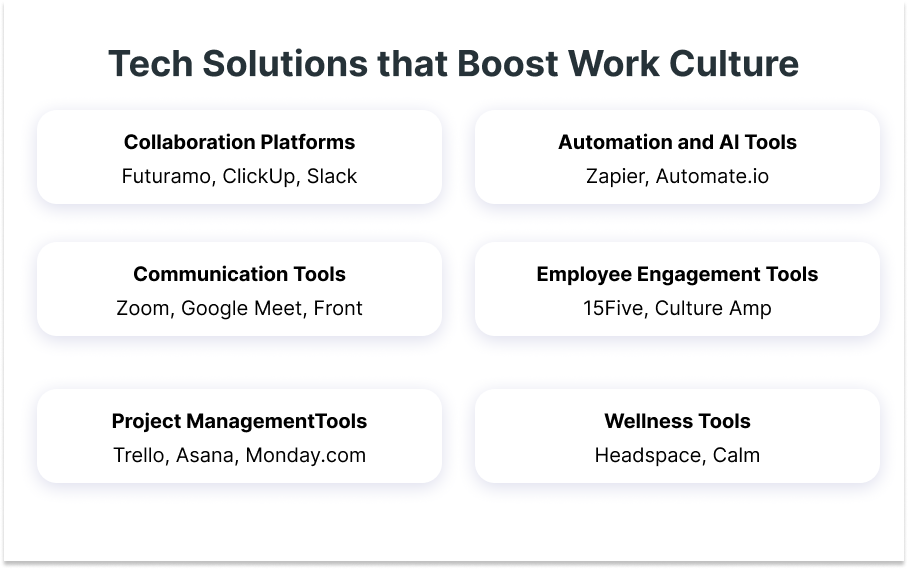Work culture isn’t just a buzzword; it’s the lifeblood of your organization. It’s comprised of the values, beliefs, attitudes, and behaviors your employees live by daily. A thriving work culture boosts productivity, employee satisfaction, and retention rates.
Digital transformation is spreading like wildfire, and companies face a new challenge: How do you preserve a healthy work culture? When most of our work happens on screens, the answer lies in using the right tech solutions. What are those?

Collaboration Platforms for Improved Work Culture
The first type of tools isn’t merely about staying connected; it’s about creating a positive work culture where every team member can thrive. An effective platform fosters a sense of unity and shared purpose, even when everyone is miles apart.
These tools must be intuitive, flexible, and multifunctional. They should enable seamless communication, streamline project management, and simplify task tracking. Great collaboration platforms offer features like file sharing, real-time updates, and integration with other essential tools.
Additionally, these platforms contribute to a strong company culture by promoting effective communication and aligning company values with employee experiences.
Examples of collaboration platforms that boost work culture include ClickUp, and Slack. However, for more specialized tasks, such as work in a legal department, companies may opt for a platform that offers legal online forms. This allows the entire legal team to interact with and modify the document as needed.
How Communication Tools Affect Work Culture?
Effective communication is the backbone of any thriving team. In a digital workspace, having the right tools can make all the difference by fostering clear, consistent, and efficient interactions. These tools contribute significantly to a positive workplace culture by promoting open communication and collaboration.
These tools keep everyone on the same page and ensure that important information is shared and understood promptly. Soliciting employee feedback through these tools not only enhances engagement but also ensures that leadership is informed by diverse perspectives.
Communication tools can be divided into:
- Video conferencing: Platforms like Zoom and Google Meet enable face-to-face meetings from anywhere worldwide.
- Email and shared Inboxes: Tools like Front and Missive streamline managing group emails.
Project Management and Task Management Tools in Work Culture
The next solution should offer features like task assignment, progress tracking, deadline notifications, and seamless integration with other work platforms. Project management tools enhance the employee experience by providing clarity and reducing stress.
They should also provide visibility into each project stage, ensuring every team member knows what’s happening and when.
To implement project management tools, the team should understand the type of solutions that will work best for them:
- Kanban boards: Trello and Asana are leaders in visual task management. They offer intuitive boards where tasks can be moved through different stages, making workflows transparent and easy to manage.
- Gantt charts: Monday.com and Wrike provide a comprehensive view of project timelines. These tools are perfect for visualizing project schedules and dependencies, helping teams stay on track and manage long-term projects precisely.
- Integrated platforms: There are dozens of platforms that shine here, combining multiple functionalities into one powerful platform. It includes task and project management features and integrates communication, bug tracking, and time tracking, ensuring all aspects of a project are covered under one roof.
Automation and AI Tools for Employee Retention
Smart tools drastically reduce the time spent on manual tasks, allowing your team to focus on more strategic initiatives. Additionally, automation and AI tools can shape and improve organizational culture by making work processes more efficient.
These tools should offer capabilities like workflow automation, task prediction, and intelligent analytics to make your team’s work more innovative and efficient.
Tools like Zapier and Automate.io eliminate the need for repetitive manual tasks. They connect various apps and automate workflows, enabling your team to focus on what truly matters.
With platforms like ClickUp utilizing AI for predictive tasking, work becomes smarter, not harder. These tools can suggest optimal deadlines, prioritize tasks based on urgency and importance, and even predict potential bottlenecks, making project management much more efficient.
Employee Engagement and Feedback and Wellness Tools
How do you keep employees engaged and ensure their well-being in a positive company culture? Some tools facilitate continuous feedback, support mental health, and foster team cohesion, even from a distance.
Speaking of feedback platforms, 15Five and Culture Amp foster a culture of continuous feedback. They allow employees to share their thoughts and concerns regularly, leading to a more engaged and motivated workforce. Wellness apps like Headspace and Calm contribute to employee retention by offering virtual well-being support, which is crucial for remote workers.
As for the wellness apps, Headspace and Calm offer virtual well-being support, which is crucial for remote workers. These apps provide guided meditations, stress-relief exercises, and sleep aids to help maintain mental health. Fostering a great company culture involves using these tools to enhance employee satisfaction and productivity.
Conclusion
Keeping a healthy corporate culture alive during digital transformation is essential. A positive workplace culture can significantly improve employee well-being and business outcomes. Conversely, a toxic workplace culture can have detrimental effects on employee engagement and overall business success.
The right tech solutions can close the physical and remote work gap, boosting unity and productivity.
From collaboration and communication tools to project management, automation, and wellness platforms, there’s a broad array of technologies to choose from. Encourage your team to try out and test different apps to see which ones work best.
By zeroing in on the right tools, you’ll build up a motivated, cohesive, and efficient workforce ready to thrive in the digital age.
⸻ Author Bio ⸻
Inna Chumachenko, Head of Content at Lawrina, a legaltech company focused on making the law more accessible to everyone. With over 6 years of experience in content creation and marketing, Inna thrives on collaborating with experts from various fields. She transforms complex legal information into easy-to-understand pieces, ensuring that Lawrina’s content is both useful and engaging for its audience.












